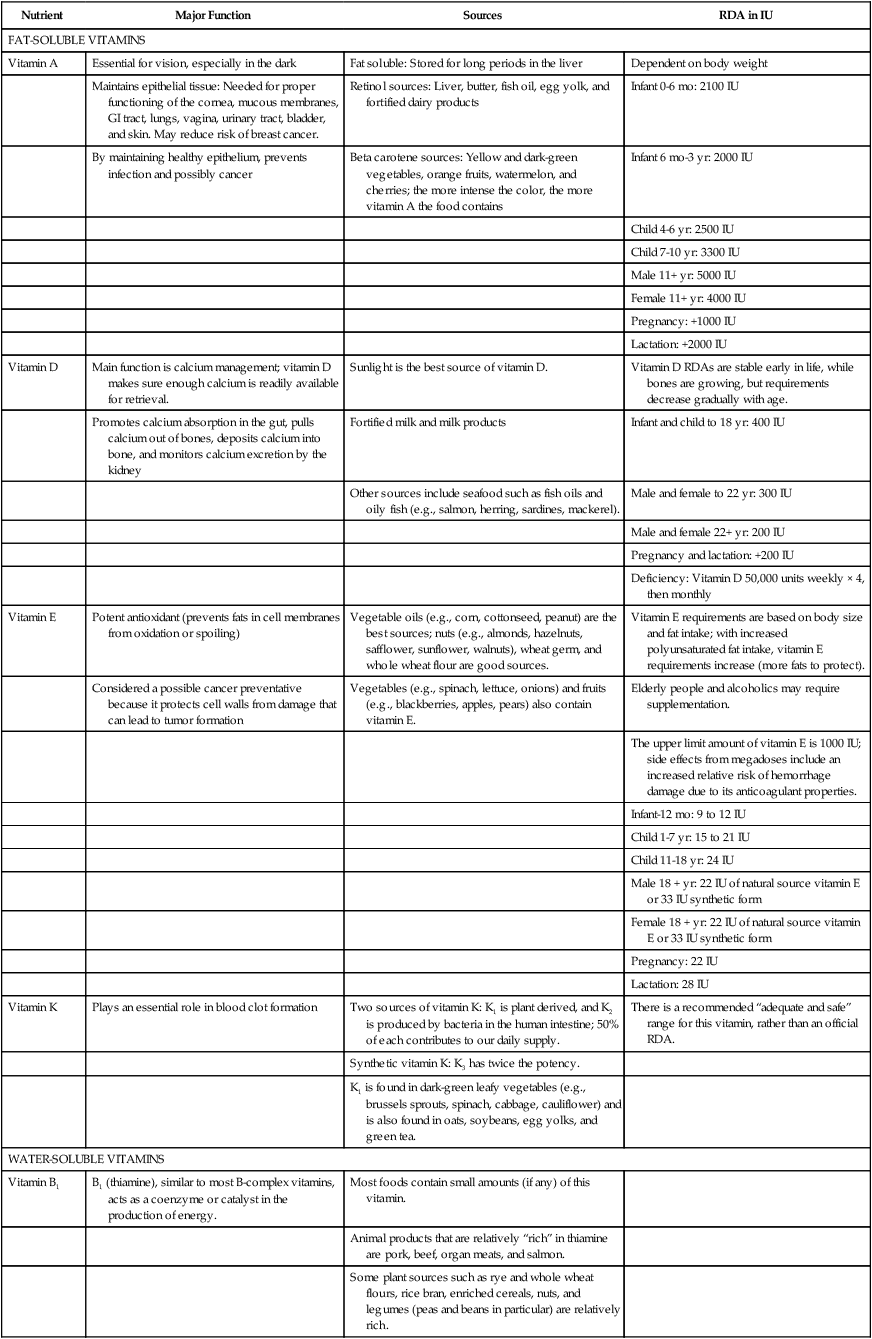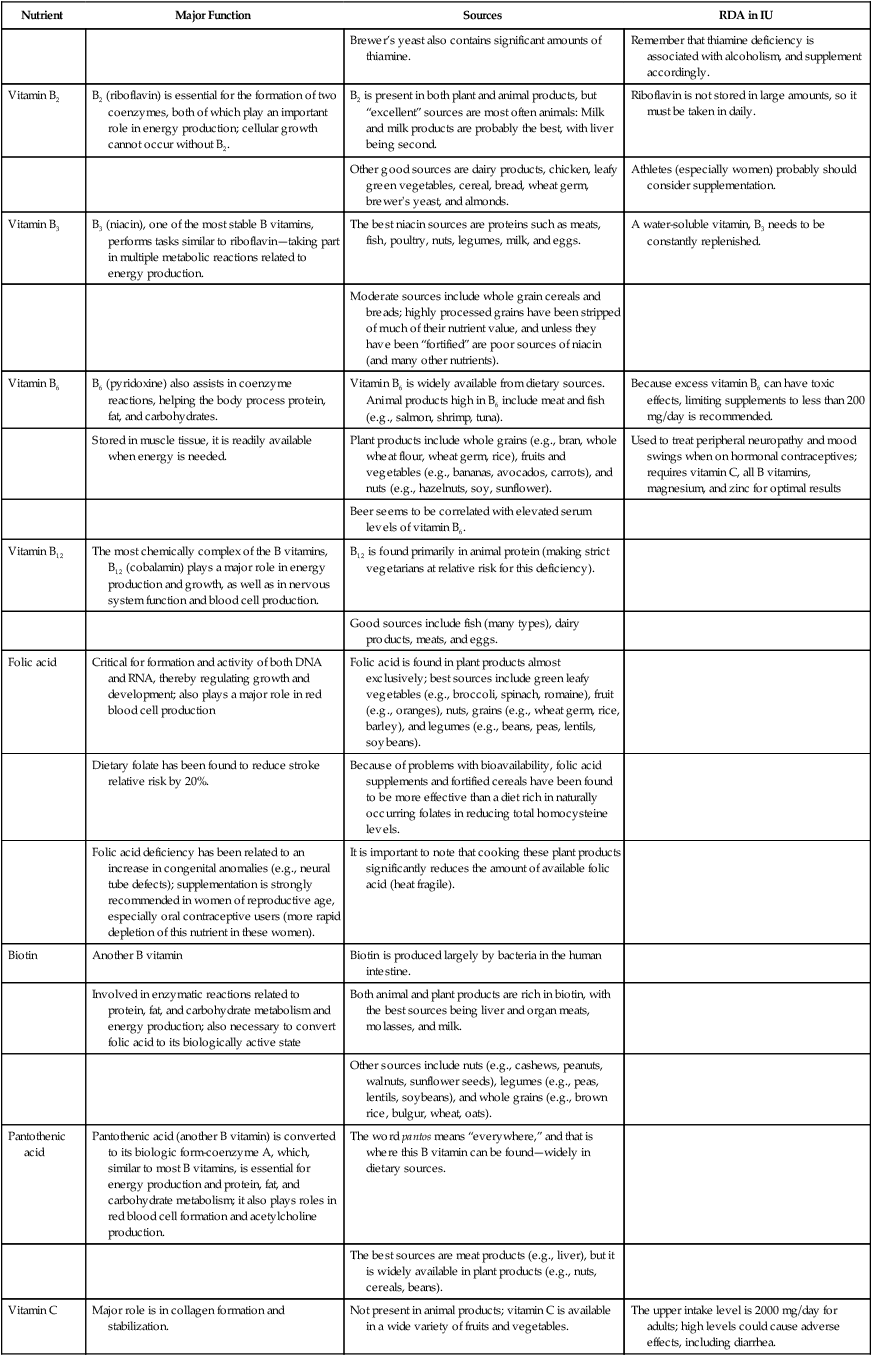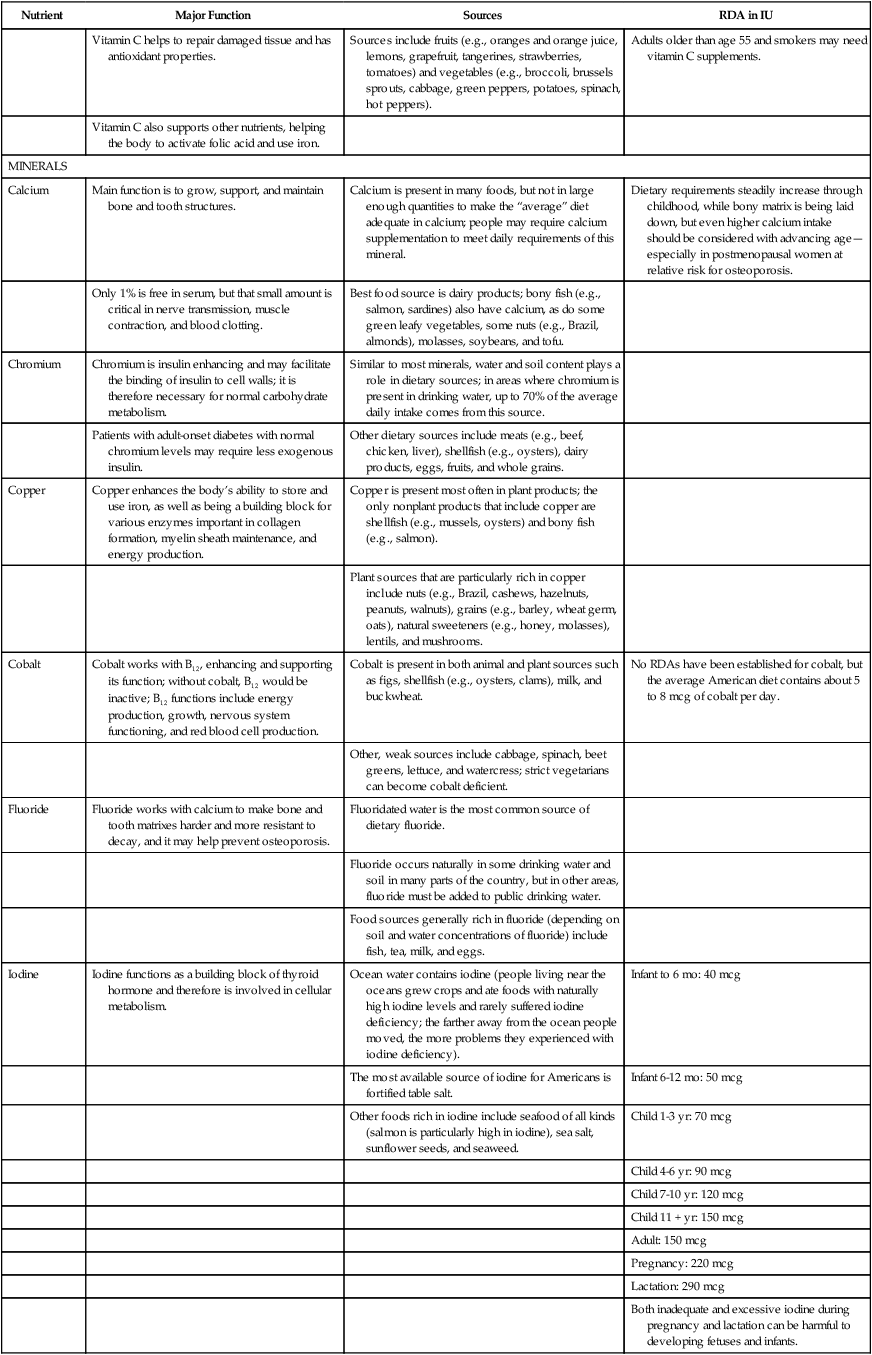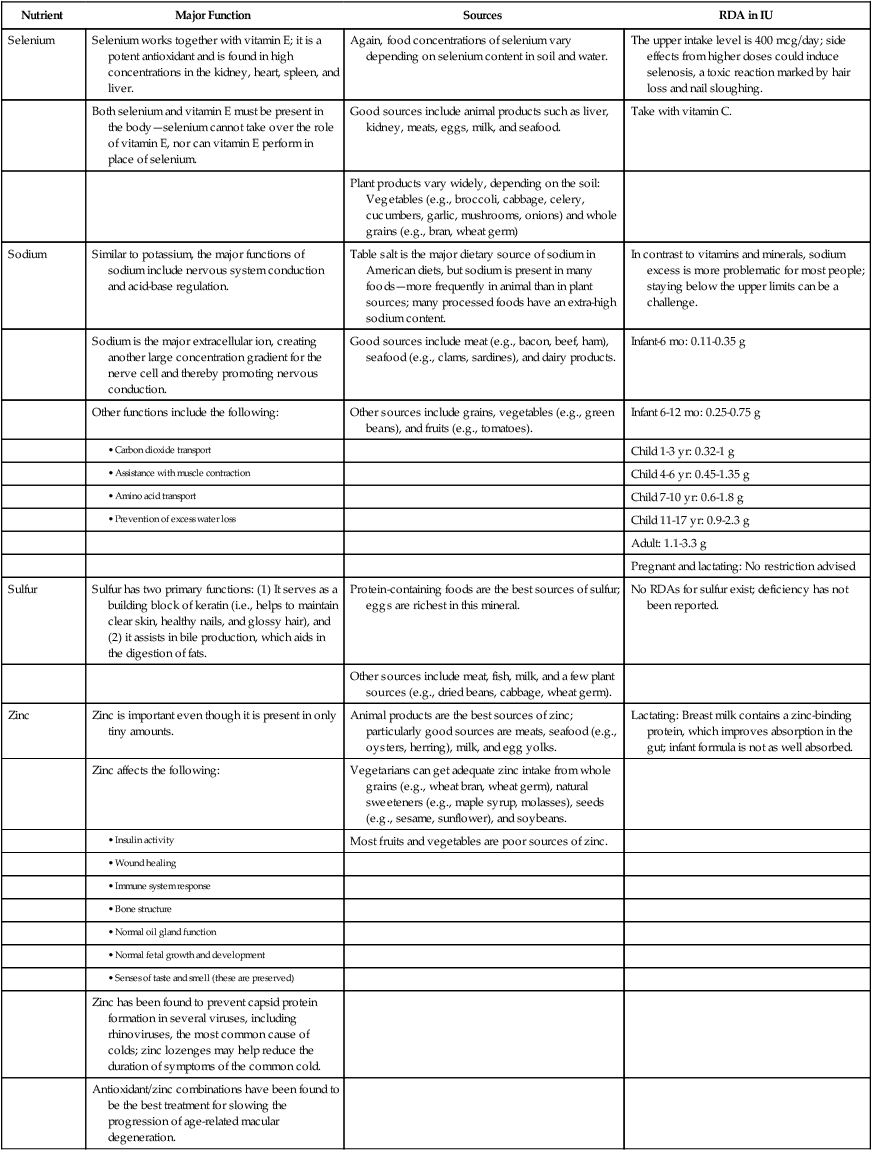Chapter 73 Vitamins and minerals are by definition essential for human life, and their role in basic metabolism has been well researched (Table 73-1). However, extensive new research documents their role in health promotion and disease prevention. This is a rapidly developing field, and it is necessary for the provider to keep current with the latest research. A number of nutrients have come onto the market after varying levels of research were conducted to support their use. These include lutein, phenols, date seed, and isoflavones. Some of these may prove helpful as additional studies define their usefulness in clinical practice; however, these trials and nutrients are not discussed here. Although these vitamins and minerals are discussed separately in this text, they are most commonly taken in multivitamin combinations, often including special formulations for pediatric or geriatric persons, or supplements that help to control hot flashes for menopausal women. Vitamin supplementation in correct doses requires inclusion of other vitamins and minerals as coenzymes, and so it is not only cheaper but more effective to package these products together. TABLE 73-1 Summary of Important Information about Vitamins and Minerals Although most people get enough vitamins to avoid the classic deficiency diseases, earlier research suggests that relatively few get enough of the five key vitamins. These include folic acid and vitamins B6, B12, D, and E. A standard, store brand, RDA-level multivitamin can supply enough of these vitamins for less than $40 a year. It may be difficult to find high-quality information about vitamins, minerals, and specific products because of the influence of the food industry. Information about nutrients should be obtained from reputable sources, such as the NIH Office of Dietary Supplementation (see http://dietary-supplements.info.nih.gov/), the Institute of Medicine, or agencies and associations that do not have products to sell. Because no uniform manufacturing rules for supplements have been put forth, some research suggests that a multivitamin may not contain what the bottle claims, could be contaminated with something from the manufacturing plant, or might include tainted ingredients—all of which suggests that products should be bought from reputable companies. The safest products have been independently reviewed and will carry a Consumer Lab seal or clearance by USP. See Box 73-1 for a list of where to get reliable information about nutritional products.
Vitamins and Minerals
Class
Generic Name
Trade Name Examples
Multivitamins
general multivitamins
Various OTC
multivitamins with minerals
Various OTC
multivitamins with fluoride
Poly-Vi-Flor with Iron, Vi-Daylin/F Chewable Multivitamin Tablets, Vi-Daylin/F Multivitamin + Iron Chewable Tablets
parenteral multivitamins
Various: Aquason A Parentera, Neurodep Injection, Vicam Injection
prenatal vitamins (OTC)
Various: Mynatal, Natalins, Nestabs FA, Niferex-PN
prenatal Rx tablets
StuartNatal Plus Tablets
Other multivitamin formulations and products
anti-folic acid antagonists
Leucovorin Calcium for Injection (Rx), Leucovorin Calcium Tablets
antioxidant combinations
Various
geriatric vitamin formulations
Various
pediatric vitamin formulations
Various
pediatric vitamins with fluoride
Various
iron combinations
Multiple: Fumatinic, Iberet-Folic-500, Hemocyte-F, NephPlex
Individual vitamins and minerals
vitamin A
Aquasol A Drops, Capsules, Injection
vitamin B1 (thiamine)
Thiamine HCl Injection
vitamin B3 (niacin)
Nicotinic Acid Capsules, Nicobid, Nicolar, Slo-Niacin Controlled Release Tablets
vitamin B6 (pyridoxine)
Pyridoxine Injection
vitamin B12
Hydrocobalamin Injection
vitamin C (ascorbic acid)
Ascorbic Acid Injection
Cenolate
vitamin D (calcitrol)
Calcijex Injection
Rocaltrol Capsules
vitamin K
AquaMEPHYTON Injection (Rx)
Mephyton Tablets
calcium
Calphron
PhosLo
fluoride
Luride Drops
Luride Lozi-Tabs Tablets
Pediaflor Drops
folic acid
Folvite Injection, Folic Acid Tablets
phosphorus
Various: K-Phos Neutral Tablets, Neutra-Phos, Neutra-Phos K,Uro-KP Neutral
zinc
Zincate
Nutrient
Major Function
Sources
RDA in IU
FAT-SOLUBLE VITAMINS
Vitamin A
Essential for vision, especially in the dark
Fat soluble: Stored for long periods in the liver
Dependent on body weight
Maintains epithelial tissue: Needed for proper functioning of the cornea, mucous membranes, GI tract, lungs, vagina, urinary tract, bladder, and skin. May reduce risk of breast cancer.
Retinol sources: Liver, butter, fish oil, egg yolk, and fortified dairy products
Infant 0-6 mo: 2100 IU
By maintaining healthy epithelium, prevents infection and possibly cancer
Beta carotene sources: Yellow and dark-green vegetables, orange fruits, watermelon, and cherries; the more intense the color, the more vitamin A the food contains
Infant 6 mo-3 yr: 2000 IU
Child 4-6 yr: 2500 IU
Child 7-10 yr: 3300 IU
Male 11+ yr: 5000 IU
Female 11+ yr: 4000 IU
Pregnancy: +1000 IU
Lactation: +2000 IU
Vitamin D
Main function is calcium management; vitamin D makes sure enough calcium is readily available for retrieval.
Sunlight is the best source of vitamin D.
Vitamin D RDAs are stable early in life, while bones are growing, but requirements decrease gradually with age.
Promotes calcium absorption in the gut, pulls calcium out of bones, deposits calcium into bone, and monitors calcium excretion by the kidney
Fortified milk and milk products
Infant and child to 18 yr: 400 IU
Other sources include seafood such as fish oils and oily fish (e.g., salmon, herring, sardines, mackerel).
Male and female to 22 yr: 300 IU
Male and female 22+ yr: 200 IU
Pregnancy and lactation: +200 IU
Deficiency: Vitamin D 50,000 units weekly × 4, then monthly
Vitamin E
Potent antioxidant (prevents fats in cell membranes from oxidation or spoiling)
Vegetable oils (e.g., corn, cottonseed, peanut) are the best sources; nuts (e.g., almonds, hazelnuts, safflower, sunflower, walnuts), wheat germ, and whole wheat flour are good sources.
Vitamin E requirements are based on body size and fat intake; with increased polyunsaturated fat intake, vitamin E requirements increase (more fats to protect).
Considered a possible cancer preventative because it protects cell walls from damage that can lead to tumor formation
Vegetables (e.g., spinach, lettuce, onions) and fruits (e.g., blackberries, apples, pears) also contain vitamin E.
Elderly people and alcoholics may require supplementation.
The upper limit amount of vitamin E is 1000 IU; side effects from megadoses include an increased relative risk of hemorrhage damage due to its anticoagulant properties.
Infant-12 mo: 9 to 12 IU
Child 1-7 yr: 15 to 21 IU
Child 11-18 yr: 24 IU
Male 18 + yr: 22 IU of natural source vitamin E or 33 IU synthetic form
Female 18 + yr: 22 IU of natural source vitamin E or 33 IU synthetic form
Pregnancy: 22 IU
Lactation: 28 IU
Vitamin K
Plays an essential role in blood clot formation
Two sources of vitamin K: K1 is plant derived, and K2 is produced by bacteria in the human intestine; 50% of each contributes to our daily supply.
There is a recommended “adequate and safe” range for this vitamin, rather than an official RDA.
Synthetic vitamin K: K3 has twice the potency.
K1 is found in dark-green leafy vegetables (e.g., brussels sprouts, spinach, cabbage, cauliflower) and is also found in oats, soybeans, egg yolks, and green tea.
WATER-SOLUBLE VITAMINS
Vitamin B1
B1 (thiamine), similar to most B-complex vitamins, acts as a coenzyme or catalyst in the production of energy.
Most foods contain small amounts (if any) of this vitamin.
Animal products that are relatively “rich” in thiamine are pork, beef, organ meats, and salmon.
Some plant sources such as rye and whole wheat flours, rice bran, enriched cereals, nuts, and legumes (peas and beans in particular) are relatively rich.
Brewer’s yeast also contains significant amounts of thiamine.
Remember that thiamine deficiency is associated with alcoholism, and supplement accordingly.
Vitamin B2
B2 (riboflavin) is essential for the formation of two coenzymes, both of which play an important role in energy production; cellular growth cannot occur without B2.
B2 is present in both plant and animal products, but “excellent” sources are most often animals: Milk and milk products are probably the best, with liver being second.
Riboflavin is not stored in large amounts, so it must be taken in daily.
Other good sources are dairy products, chicken, leafy green vegetables, cereal, bread, wheat germ, brewer’s yeast, and almonds.
Athletes (especially women) probably should consider supplementation.
Vitamin B3
B3 (niacin), one of the most stable B vitamins, performs tasks similar to riboflavin—taking part in multiple metabolic reactions related to energy production.
The best niacin sources are proteins such as meats, fish, poultry, nuts, legumes, milk, and eggs.
A water-soluble vitamin, B3 needs to be constantly replenished.
Moderate sources include whole grain cereals and breads; highly processed grains have been stripped of much of their nutrient value, and unless they have been “fortified” are poor sources of niacin (and many other nutrients).
Vitamin B6
B6 (pyridoxine) also assists in coenzyme reactions, helping the body process protein, fat, and carbohydrates.
Vitamin B6 is widely available from dietary sources.
Animal products high in B6 include meat and fish (e.g., salmon, shrimp, tuna).
Because excess vitamin B6 can have toxic effects, limiting supplements to less than 200 mg/day is recommended.
Stored in muscle tissue, it is readily available when energy is needed.
Plant products include whole grains (e.g., bran, whole wheat flour, wheat germ, rice), fruits and vegetables (e.g., bananas, avocados, carrots), and nuts (e.g., hazelnuts, soy, sunflower).
Used to treat peripheral neuropathy and mood swings when on hormonal contraceptives; requires vitamin C, all B vitamins, magnesium, and zinc for optimal results
Beer seems to be correlated with elevated serum levels of vitamin B6.
Vitamin B12
The most chemically complex of the B vitamins, B12 (cobalamin) plays a major role in energy production and growth, as well as in nervous system function and blood cell production.
B12 is found primarily in animal protein (making strict vegetarians at relative risk for this deficiency).
Good sources include fish (many types), dairy products, meats, and eggs.
Folic acid
Critical for formation and activity of both DNA and RNA, thereby regulating growth and development; also plays a major role in red blood cell production
Folic acid is found in plant products almost exclusively; best sources include green leafy vegetables (e.g., broccoli, spinach, romaine), fruit (e.g., oranges), nuts, grains (e.g., wheat germ, rice, barley), and legumes (e.g., beans, peas, lentils, soybeans).
Dietary folate has been found to reduce stroke relative risk by 20%.
Because of problems with bioavailability, folic acid supplements and fortified cereals have been found to be more effective than a diet rich in naturally occurring folates in reducing total homocysteine levels.
Folic acid deficiency has been related to an increase in congenital anomalies (e.g., neural tube defects); supplementation is strongly recommended in women of reproductive age, especially oral contraceptive users (more rapid depletion of this nutrient in these women).
It is important to note that cooking these plant products significantly reduces the amount of available folic acid (heat fragile).
Biotin
Another B vitamin
Biotin is produced largely by bacteria in the human intestine.
Involved in enzymatic reactions related to protein, fat, and carbohydrate metabolism and energy production; also necessary to convert folic acid to its biologically active state
Both animal and plant products are rich in biotin, with the best sources being liver and organ meats, molasses, and milk.
Other sources include nuts (e.g., cashews, peanuts, walnuts, sunflower seeds), legumes (e.g., peas, lentils, soybeans), and whole grains (e.g., brown rice, bulgur, wheat, oats).
Pantothenic acid
Pantothenic acid (another B vitamin) is converted to its biologic form-coenzyme A, which, similar to most B vitamins, is essential for energy production and protein, fat, and carbohydrate metabolism; it also plays roles in red blood cell formation and acetylcholine production.
The word pantos means “everywhere,” and that is where this B vitamin can be found—widely in dietary sources.
The best sources are meat products (e.g., liver), but it is widely available in plant products (e.g., nuts, cereals, beans).
Vitamin C
Major role is in collagen formation and stabilization.
Not present in animal products; vitamin C is available in a wide variety of fruits and vegetables.
The upper intake level is 2000 mg/day for adults; high levels could cause adverse effects, including diarrhea.
Vitamin C helps to repair damaged tissue and has antioxidant properties.
Sources include fruits (e.g., oranges and orange juice, lemons, grapefruit, tangerines, strawberries, tomatoes) and vegetables (e.g., broccoli, brussels sprouts, cabbage, green peppers, potatoes, spinach, hot peppers).
Adults older than age 55 and smokers may need vitamin C supplements.
Vitamin C also supports other nutrients, helping the body to activate folic acid and use iron.
MINERALS
Calcium
Main function is to grow, support, and maintain bone and tooth structures.
Calcium is present in many foods, but not in large enough quantities to make the “average” diet adequate in calcium; people may require calcium supplementation to meet daily requirements of this mineral.
Dietary requirements steadily increase through childhood, while bony matrix is being laid down, but even higher calcium intake should be considered with advancing age—especially in postmenopausal women at relative risk for osteoporosis.
Only 1% is free in serum, but that small amount is critical in nerve transmission, muscle contraction, and blood clotting.
Best food source is dairy products; bony fish (e.g., salmon, sardines) also have calcium, as do some green leafy vegetables, some nuts (e.g., Brazil, almonds), molasses, soybeans, and tofu.
Chromium
Chromium is insulin enhancing and may facilitate the binding of insulin to cell walls; it is therefore necessary for normal carbohydrate metabolism.
Similar to most minerals, water and soil content plays a role in dietary sources; in areas where chromium is present in drinking water, up to 70% of the average daily intake comes from this source.
Patients with adult-onset diabetes with normal chromium levels may require less exogenous insulin.
Other dietary sources include meats (e.g., beef, chicken, liver), shellfish (e.g., oysters), dairy products, eggs, fruits, and whole grains.
Copper
Copper enhances the body’s ability to store and use iron, as well as being a building block for various enzymes important in collagen formation, myelin sheath maintenance, and energy production.
Copper is present most often in plant products; the only nonplant products that include copper are shellfish (e.g., mussels, oysters) and bony fish (e.g., salmon).
Plant sources that are particularly rich in copper include nuts (e.g., Brazil, cashews, hazelnuts, peanuts, walnuts), grains (e.g., barley, wheat germ, oats), natural sweeteners (e.g., honey, molasses), lentils, and mushrooms.
Cobalt
Cobalt works with B12, enhancing and supporting its function; without cobalt, B12 would be inactive; B12 functions include energy production, growth, nervous system functioning, and red blood cell production.
Cobalt is present in both animal and plant sources such as figs, shellfish (e.g., oysters, clams), milk, and buckwheat.
No RDAs have been established for cobalt, but the average American diet contains about 5 to 8 mcg of cobalt per day.
Other, weak sources include cabbage, spinach, beet greens, lettuce, and watercress; strict vegetarians can become cobalt deficient.
Fluoride
Fluoride works with calcium to make bone and tooth matrixes harder and more resistant to decay, and it may help prevent osteoporosis.
Fluoridated water is the most common source of dietary fluoride.
Fluoride occurs naturally in some drinking water and soil in many parts of the country, but in other areas, fluoride must be added to public drinking water.
Food sources generally rich in fluoride (depending on soil and water concentrations of fluoride) include fish, tea, milk, and eggs.
Iodine
Iodine functions as a building block of thyroid hormone and therefore is involved in cellular metabolism.
Ocean water contains iodine (people living near the oceans grew crops and ate foods with naturally high iodine levels and rarely suffered iodine deficiency; the farther away from the ocean people moved, the more problems they experienced with iodine deficiency).
Infant to 6 mo: 40 mcg
The most available source of iodine for Americans is fortified table salt.
Infant 6-12 mo: 50 mcg
Other foods rich in iodine include seafood of all kinds (salmon is particularly high in iodine), sea salt, sunflower seeds, and seaweed.
Child 1-3 yr: 70 mcg
Child 4-6 yr: 90 mcg
Child 7-10 yr: 120 mcg
Child 11 + yr: 150 mcg
Adult: 150 mcg
Pregnancy: 220 mcg
Lactation: 290 mcg
Both inadequate and excessive iodine during pregnancy and lactation can be harmful to developing fetuses and infants.
Iron
Iron is an essential part of hemoglobin and is critical for oxygen transport.
Iron has many sources, both animal and plant; this abundance is vital because humans have trouble absorbing iron; they are able to use only about 10% of the iron that is available in the diet, except in pregnancy, when absorption increases to 15%.
The best iron sources are animal—liver and other organ meats.
Other good sources include dried fruits, beans, dark-green leafy vegetables, shellfish, enriched bread, grains (e.g., wheat germ, whole grains), nuts and seeds (e.g., cashews, pistachios, walnuts, pumpkin), and natural sweeteners (e.g., molasses).
Difficult to eat enough of any one of these foods for adequate supplementation. Do not take iron supplements with Ca++ or milk, which may block absorption.
Magnesium
Magnesium plays multiple roles: (1) promoting absorption of other minerals, (2) removing excessive amounts of other minerals, (3) assisting in nervous conduction, (4) enhancing protein metabolism, and (5) binding calcium to tooth enamel.
Magnesium is important in photosynthesis, so vegetables high in chlorophyll are good sources.
Animal products contain small amounts of magnesium (amount varies depending on the animal’s diet), although fish contains relatively high levels.
Good sources include green leafy vegetables, seafood (many fish and shellfish), fruits and fruit juice, nuts and seeds (e.g., almonds, sunflower), molasses, soybeans, and wheat germ.
Pregnancy and lactation: Should come from dietary sources; supplementation during pregnancy and lactation is not recommended.
Manganese
Manganese is a “helper” nutrient—important in some biochemical reactions—but other minerals can perform these roles, so the presence of manganese is not critical.
Manganese is available from both plant and animal sources.
Tolerable upper limit in adults is 11 mg/day; neurologic adverse effects, similar to symptoms caused by Parkinson’s disease, have been observed in individuals who have consumed high amounts of manganese, and iron absorption by the body may be inhibited.
The main functions include energy production, glucose management, assistance with vitamin usage, and help in forming proper bone and collagen.
Good sources include organ meats, muscle meats, leafy green vegetables (e.g., spinach, tea, lettuce), nuts and beans, and whole grain cereals and breads.
Some glucosamine and chondroitin products have excessively high levels of manganese.
Pregnancy and lactation: Supplementation is not recommended.
Molybdenum
Plays two major roles: (1) Assists in maintaining body iron reserves, (2) helps to use fat stores for energy
Similar to other minerals, concentrations in plant and animal foods depend on soil and water concentrations of this mineral; water alone (if rich in molybdenum) can provide more than 40% of the RDA.
Good sources include dark-green leafy vegetables, organ meats, beans, and grains.
Phosphorus
Phosphorus plays a major role in bone and tooth structure. It is also present in every cell in the body (appearing as part of cellular DNA) and is fundamental to body tissue growth, maintenance, and repair.
Because it is an essential part of cellular structure, meat is an excellent source of phosphorus.
Good sources: All types of meat, seafood, milk and milk products, eggs
Plant sources rich in phosphorus include nuts and seeds (e.g., almonds, peanuts, pumpkin, sunflower), legumes (e.g., beans, peas, and soybeans), and whole grains.
Potassium
Almost 100% of the body’s potassium stores are intracellular, creating a large concentration gradient across the cell membrane; this sets the stage for depolarization and nerve transmission.
Potassium is found in a wide assortment of foods, both animal and plant.
Dietary salt intake affects the body’s levels of potassium inversely: Increased sodium intake = decreased potassium.
Potassium also does the following:
Some of the best sources are plants; sources include fruits (e.g., avocado, banana, citrus, raisins, dried peaches, tomatoes), vegetables (e.g., spinach, parsnips, potatoes), nuts (e.g., almonds, Brazil nuts, cashews, peanuts, pecans, walnuts), dairy products, whole grain cereals, legumes, and molasses.
Some experts suggest that minimum daily requirements should be 2000 to 2500 mg; the “average” American diet provides between 2000 and 6000 mg daily, so potassium deficiency is not common unless disease states or medications interfere with body stores.
Animal sources include lean meats and some seafood (e.g., sardines).
Selenium
Selenium works together with vitamin E; it is a potent antioxidant and is found in high concentrations in the kidney, heart, spleen, and liver.
Again, food concentrations of selenium vary depending on selenium content in soil and water.
The upper intake level is 400 mcg/day; side effects from higher doses could induce selenosis, a toxic reaction marked by hair loss and nail sloughing.
Both selenium and vitamin E must be present in the body—selenium cannot take over the role of vitamin E, nor can vitamin E perform in place of selenium.
Good sources include animal products such as liver, kidney, meats, eggs, milk, and seafood.
Take with vitamin C.
Plant products vary widely, depending on the soil: Vegetables (e.g., broccoli, cabbage, celery, cucumbers, garlic, mushrooms, onions) and whole grains (e.g., bran, wheat germ)
Sodium
Similar to potassium, the major functions of sodium include nervous system conduction and acid-base regulation.
Table salt is the major dietary source of sodium in American diets, but sodium is present in many foods—more frequently in animal than in plant sources; many processed foods have an extra-high sodium content.
In contrast to vitamins and minerals, sodium excess is more problematic for most people; staying below the upper limits can be a challenge.
Sodium is the major extracellular ion, creating another large concentration gradient for the nerve cell and thereby promoting nervous conduction.
Good sources include meat (e.g., bacon, beef, ham), seafood (e.g., clams, sardines), and dairy products.
Infant-6 mo: 0.11-0.35 g
Other functions include the following:
Other sources include grains, vegetables (e.g., green beans), and fruits (e.g., tomatoes).
Infant 6-12 mo: 0.25-0.75 g
Child 1-3 yr: 0.32-1 g
Child 4-6 yr: 0.45-1.35 g
Child 7-10 yr: 0.6-1.8 g
Child 11-17 yr: 0.9-2.3 g
Adult: 1.1-3.3 g
Pregnant and lactating: No restriction advised
Sulfur
Sulfur has two primary functions: (1) It serves as a building block of keratin (i.e., helps to maintain clear skin, healthy nails, and glossy hair), and (2) it assists in bile production, which aids in the digestion of fats.
Protein-containing foods are the best sources of sulfur; eggs are richest in this mineral.
No RDAs for sulfur exist; deficiency has not been reported.
Other sources include meat, fish, milk, and a few plant sources (e.g., dried beans, cabbage, wheat germ).
Zinc
Zinc is important even though it is present in only tiny amounts.
Animal products are the best sources of zinc; particularly good sources are meats, seafood (e.g., oysters, herring), milk, and egg yolks.
Lactating: Breast milk contains a zinc-binding protein, which improves absorption in the gut; infant formula is not as well absorbed.
Zinc affects the following:
Vegetarians can get adequate zinc intake from whole grains (e.g., wheat bran, wheat germ), natural sweeteners (e.g., maple syrup, molasses), seeds (e.g., sesame, sunflower), and soybeans.
Most fruits and vegetables are poor sources of zinc.
Zinc has been found to prevent capsid protein formation in several viruses, including rhinoviruses, the most common cause of colds; zinc lozenges may help reduce the duration of symptoms of the common cold.
Antioxidant/zinc combinations have been found to be the best treatment for slowing the progression of age-related macular degeneration.





Basicmedical Key
Fastest Basicmedical Insight Engine



